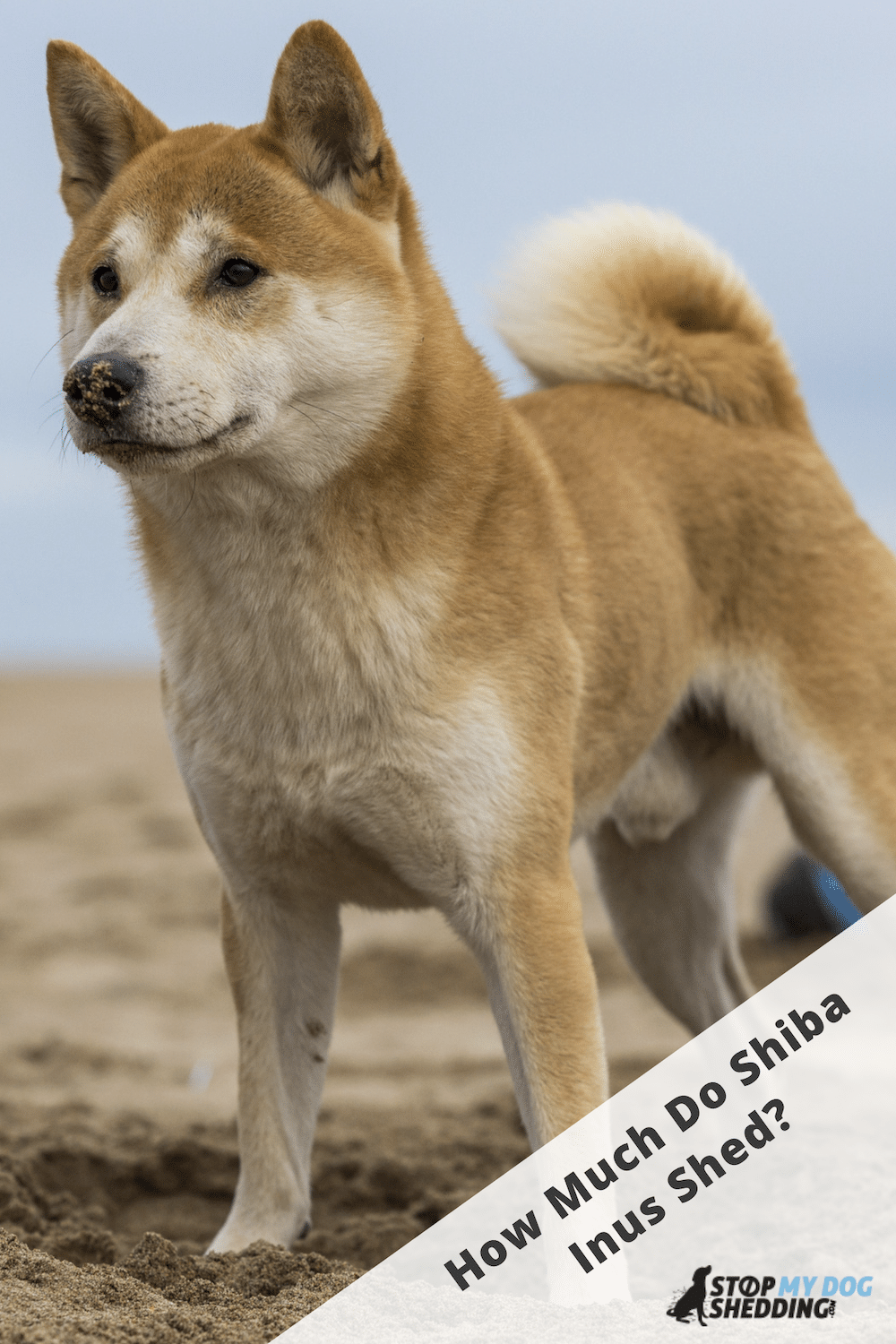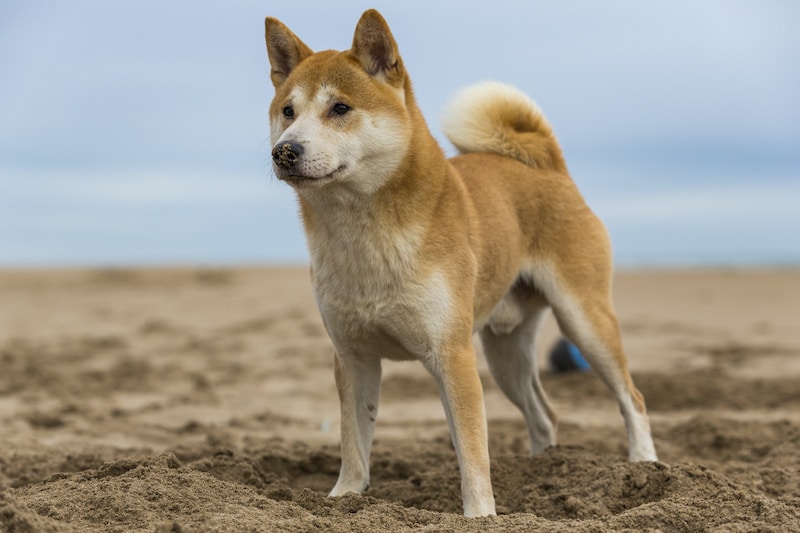The Shiba Inu is a small to medium Japanese mountain dog that was purpose bred for hunting. He makes an excellent companion as well as watchdog, given his keen senses and alertness.
How much do they shed?
Shiba Inus are a high shedding breed.
They tend to shed fairly evenly throughout the year but they shed their undercoat (blow coat) twice per year which amplifies the shedding quite a bit for about 3-4 weeks. On the plus side, they’re not very difficult to groom, so regular brushing is typically all that’s required.
In this article, we’ll be taking a closer look at how much Shiba Inus shed, what they’re like to groom, and what you can do to reduce the shedding as much as possible.
Recommended: Go here to see our top-rated dog hair blow dryers
Shiba Inu Shedding
There’s no getting around it, Shiba Inus shed a lot of hair.
Most of the hair they lose is spread fairly evenly throughout the year, but the shedding typically steps up a few notches during seasonal changes like spring and fall.
This is referred to as “blowing coat” because what they are doing is pushing out the old undercoat (which is made up of thick, soft fur) to make way for a new undercoat that will serve them in the months ahead.
This is perfectly normal among double coated breeds like Shiba Inus, so you can’t (and shouldn’t try to) stop it. Other breeds that have an undercoat include the Alaskan Malamute, German Shepherd, Mountain Dog and Russian Terrier for example.
Generally speaking, your best line of defence against a high amount of shedding is maintaining a regular grooming regime, which mostly consists of brushing as I’ll now explain.
Recommended: Go here to see our top-rated dog hair blow dryers
What Are They Like to Groom?
Shiba Inus do shed lots, but thankfully they’re not very difficult to groom.
In fact, they don’t really require any special grooming beyond what most dogs do to keep their coat in good shape. This is mostly because of the rugged nature of their top coat which is made up of tough, straight, fairly short (about one inch long) guard hairs that are protect against rain and snow.
The coat isn’t prone to matts, knots or tangles, and can be pretty much left as is. They’re also quite a fastidious breed in that they clean themselves regularly, kind of like how cats do, along with other breeds like the Basenji.
So, shedding aside, they’re very low maintenance.
However, you may personally want to step the brushing up to help keep the shedding under control. And because they have such a thick double coat, it will take more work to remove the dead hairs through brushing than most dogs.
Summary: brushing your Shiba 3-5 times per week isn’t “essential,” but this is definitely one of the best ways to keep their shedding under control.
The best brush to use is probably a slicker or pin brush, followed by a good quality deshedding tool during times of heavy shedding activity.
Read: Four Types of Dog Brushes Compared
The idea is to start by giving her a once over with a slicker brush to remove the bulk of dead hair on the top coat, then follow up with a fine shedding comb that reaches right down to the undercoat, to remove that thick, loose fur.
You might be surprised at the huge difference this can make, especially if it’s the first time you’ve done it during shedding season. And you can even use a blower as you brush to help blow the hair away. Something like a cool hair blower or reverse vacuum should do the trick.
Recommended: Go here to see our top-rated dog hair blow dryers
Are Shiba Inus Hypoallergenic?
No, Shiba Inus are definitely not hypoallergenic.
There’s a lot of controversy over what exactly this means, and technically speaking there are no hypoallergenic breeds, all dogs can cause allergies to flare up.
It’s just that some breeds are more hypoallergenic than others, meaning they are less likely to cause an allergic reaction than some other breeds. And one of the determining factors with this is how much they shed.
The thing that makes people sneeze isn’t the hair itself, but rather the dried saliva and dander (dead skin) on the dog that finds its way into the air on its own and by attaching itself to loose hair.
So in other words, high shedding breeds are less hypoallergenic by default because less hair floating around typically means less allergens, even though the source is saliva and dander.
How to Reduce Excessive Shedding
The best way to reduce excessive shedding is through regular brushing. Simply brushing your dog with a slicker brush or deshedder a few times per week can make a huge difference.
Not just because brushing removes loose fur, but because it can help distribute the oils of her coat evenly over her skin, which acts as a preventative for excess shedding.
Aside from brushing, there are other things to consider.
For example: if you notice your Shiba is losing more hair than normal, and it’s not because they’re blowing coat, then they may have dry, irritated skin. Which can be caused by a number of things such as over bathing, a less than ideal diet, or even fleas.
The general consensus is that bathing your Shiba Inu is really only needed every few months. Especially since their coat doesn’t smell bad anyway because they self clean so often.
In any case, over bathing can potentially lead to dry skin. And when you do bath, make sure you use a good quality dog shampoo with as few chemicals as possible.
When it comes to diet, or having fleas, this is something you should probably consult your local veterinarian about.
But the general idea is to purchase a high quality, well reviewed dog food with lots of vitamins and minerals, as this can help reduce excessive shedding.
There are also some safe and effective home remedies you can try too, like adding a teaspoon of coconut oil to her food of a night, which can help moisturize her skin.
About Shiba Inus
Shiba Inus are small to medium Japanese mountain dogs that were purpose bred for hunting. They’re an ancient breed that is said to have been around since 300 B.C.
They have a keen sense of sight and smell, are very alert, agile and able to scale mountainous terrain better than most, since that is what they were bred for in Japan, to track and hunt prey in the mountains.
Shiba means “brushwood” in Japanese, which is a type of tree or shrub whose leaves turn red in the fall, and the word Inu means dog. So their name basically means “brushwood dog”.
Some say they earned this name because they are mostly red in color, and because of the brushwood trees that were common around their hunting grounds.
Either way, they were bought into the United States in 1954 and have red, orange, black, tan, yellow and sesame colored coats these days. Or some combination of these.
As far as temperament goes, they make great family companions and good watchdogs. And at the same time, don’t bark unless they really have to, so are considered suitable for apartment living.
Like most dogs though, they do need lots of exercise, so you really do want to get them out and about for some regular exercise during the day if possible.
Just be sure to keep them on the lead. Because Shiba Inus aren’t always good around other dogs and animals, and caution is needed when it comes to children.
But this is typically only the case if they are not properly socialized as pups. So if you’re set on getting a Shiba Inu, the best thing to do is get them properly trained from a puppy, so that they are well adapted when they start to mature. Professional training is especially important when it comes to Shiba Inus, as training may be challenging for novice owners.
Related Questions
Why Do Shiba Inus Shed?
All dogs shed, this is perfectly normal. It’s just that Shiba Inus shed more during seasonal changes (like spring and fall) because they have a thick double coat, and when this happens it is called “blowing coat”.
Do Shiba Inus Have Hair or Fur?
The term “hair” is synonymous with “fur” when describing a dogs coat, but in reality only a few dogs have actual hair, and the Shiba Inu isn’t one of them. It has fur on both the top coat and undercoat. The top coat consists of straight, protective fur, while the undercoat consists of thick, soft fur.
What’s The Best Brush for a Shiba Inu?
The best type of brush for a Shiba Inu is probably a slicker brush or shedding tool like the Furminator (or similar alternative brand). The slicker is typically cheaper and will do a good job most of the time, but a proper deshedding brush is well worth it during heavier periods of shedding.













Please note: By submitting a comment using the above comment form, you confirm that you agree with the storage and handling of your data by this site as detailed in our Privacy Policy.